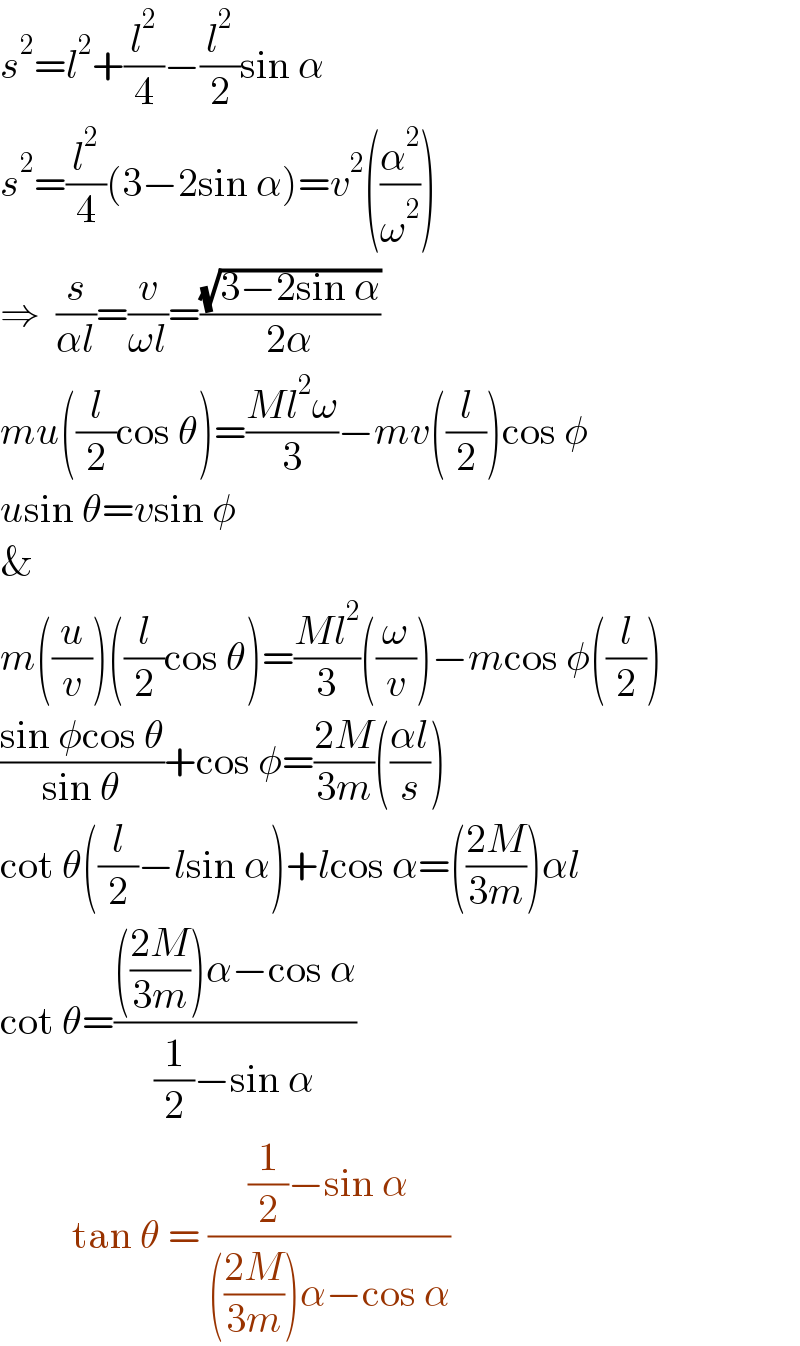
Question Number 214047 by ajfour last updated on 25/Nov/24

Commented by ajfour last updated on 25/Nov/24

$$\:{The}\:{L}\:{shaped}\:{rigid}\:{scale}\:{can}\:{turn}\: \\ $$$${about}\:{the}\:{pivot}\:{on}\:{a}\:{frictionless}\:{table}. \\ $$$$\:{The}\:{small}\:{mass}\:{m}\:{hits}\:{and}\:{after}\: \\ $$$${rebounding}\:{happens}\:{to}\:{find}\:{the} \\ $$$$\:{other}\:{end}.\:{Find}\:\theta,\:{if}\:\alpha\:{is}\:{measured}. \\ $$$$\left({Take}\:{coefficient}\:{of}\:{restitution}\:\boldsymbol{{e}}\right) \\ $$
Answered by mr W last updated on 25/Nov/24

Commented by mr W last updated on 27/Nov/24

$${u}={velocity}\:{of}\:{ball}\:{before}\:{collision} \\ $$$${v}={velocity}\:{of}\:{ball}\:{after}\:{collision} \\ $$$$\omega={angular}\:{velocity}\:{of}\:{L}−{frame} \\ $$$$\:\:\:\:\:\:\:{after}\:{collision} \\ $$$${u}\:\mathrm{sin}\:\theta={v}\:\mathrm{sin}\:\phi\:\:\:...\left({i}\right) \\ $$$${e}=\frac{{v}\:\mathrm{cos}\:\phi+\frac{\omega{l}}{\mathrm{2}}}{{u}\:\mathrm{cos}\:\theta} \\ $$$$\Rightarrow{eu}\:\mathrm{cos}\:\theta={v}\:\mathrm{cos}\:\phi+\frac{{l}\omega}{\mathrm{2}}\:\:\:...\left({ii}\right) \\ $$$${mu}\:\mathrm{cos}\:\theta×\frac{{l}}{\mathrm{2}}=\frac{{Ml}^{\mathrm{2}} \omega}{\mathrm{3}}−{mv}\:\mathrm{cos}\:\phi×\frac{{l}}{\mathrm{2}} \\ $$$$\Rightarrow{u}\:\mathrm{cos}\:\theta+{v}\:\mathrm{cos}\:\phi=\frac{\mathrm{2}{Ml}\omega}{\mathrm{3}{m}}\:\:\:...\left({iii}\right) \\ $$$${t}=\frac{\alpha}{\omega} \\ $$$$\frac{{l}}{\mathrm{2}}−{l}\:\mathrm{sin}\:\alpha={v}\:\mathrm{sin}\:\phi×{t} \\ $$$$\frac{{l}\omega}{\alpha}\left(\frac{\mathrm{1}}{\mathrm{2}}−\mathrm{sin}\:\alpha\right)={v}\:\mathrm{sin}\:\phi \\ $$$$\Rightarrow\left(\frac{\mathrm{1}}{\mathrm{2}\alpha}−\frac{\mathrm{sin}\:\alpha}{\alpha}\right){l}\omega={u}\:\mathrm{sin}\:\theta\:\:\:...\left({iv}\right) \\ $$$${l}\:\mathrm{cos}\:\alpha={v}\:\mathrm{cos}\:\phi\:×{t} \\ $$$$\frac{{l}\omega\:\mathrm{cos}\:\alpha}{\alpha}={v}\:\mathrm{cos}\:\phi\:\:\:...\left({v}\right) \\ $$$${we}\:{have}\:\mathrm{5}\:{equations}\:{for}\:\mathrm{6}\:{variables}: \\ $$$${u},\:{v},\:\omega,\:\theta,\:\phi,\:\alpha \\ $$$$ \\ $$$$\left({iii}\right): \\ $$$${u}\:\mathrm{cos}\:\theta+\frac{{l}\omega\:\mathrm{cos}\:\alpha}{\alpha}=\frac{\mathrm{2}{Ml}\omega}{\mathrm{3}{m}} \\ $$$$\left(\frac{\mathrm{2}{M}}{\mathrm{3}{m}}−\frac{\mathrm{cos}\:\alpha}{\alpha}\right){l}\omega={u}\:\mathrm{cos}\:\theta\:\:\:...\left({vi}\right) \\ $$$$\left({v}\right)\:{into}\:\left({ii}\right): \\ $$$${eu}\:\mathrm{cos}\:\theta=\frac{{l}\omega\:\mathrm{cos}\:\alpha}{\alpha}+\frac{{l}\omega}{\mathrm{2}} \\ $$$$\Rightarrow\left(\frac{\mathrm{cos}\:\alpha}{\alpha}+\frac{\mathrm{1}}{\mathrm{2}}\right)\frac{{l}\omega}{{e}}={u}\:\mathrm{cos}\:\theta \\ $$$${from}\:\left({vi}\right): \\ $$$$\left(\frac{\mathrm{cos}\:\alpha}{\alpha}+\frac{\mathrm{1}}{\mathrm{2}}\right)\frac{{l}\omega}{{e}}=\left(\frac{\mathrm{2}{M}}{\mathrm{3}{m}}−\frac{\mathrm{cos}\:\alpha}{\alpha}\right){l}\omega \\ $$$$\left(\mathrm{1}+\frac{\mathrm{1}}{{e}}\right)\frac{\mathrm{cos}\:\alpha}{\alpha}=\frac{\mathrm{2}{M}}{\mathrm{3}{m}}−\frac{\mathrm{1}}{\mathrm{2}{e}} \\ $$$$\Rightarrow\frac{\mathrm{cos}\:\alpha}{\alpha}=\frac{\frac{\mathrm{2}{M}}{\mathrm{3}{m}}−\frac{\mathrm{1}}{\mathrm{2}{e}}}{\mathrm{1}+\frac{\mathrm{1}}{{e}}}\:\:\:...\left({vii}\right) \\ $$$${since}\:\alpha<\frac{\pi}{\mathrm{6}},\:\:\frac{\frac{\mathrm{2}{M}}{\mathrm{3}{m}}−\frac{\mathrm{1}}{\mathrm{2}{e}}}{\mathrm{1}+\frac{\mathrm{1}}{{e}}}>\frac{\sqrt{\mathrm{3}}×\mathrm{6}}{\mathrm{2}×\pi} \\ $$$$\Rightarrow\:\frac{{M}}{{m}}>\frac{\mathrm{9}\sqrt{\mathrm{3}}\left(\mathrm{1}+\frac{\mathrm{1}}{{e}}\right)}{\mathrm{2}\pi}+\frac{\mathrm{3}}{\mathrm{4}{e}} \\ $$$$\left({iv}\right)/\left({vi}\right): \\ $$$$\frac{\frac{\mathrm{1}}{\mathrm{2}\alpha}−\frac{\mathrm{sin}\:\alpha}{\alpha}}{\frac{\mathrm{2}{M}}{\mathrm{3}{m}}−\frac{\mathrm{cos}\:\alpha}{\alpha}}=\mathrm{tan}\:\theta \\ $$$$\Rightarrow\theta=\mathrm{tan}^{−\mathrm{1}} \frac{\frac{\mathrm{1}}{\mathrm{2}}−\mathrm{sin}\:\alpha}{\frac{\mathrm{2}\alpha{M}}{\mathrm{3}{m}}−\mathrm{cos}\:\alpha}\:\:\:...\left({viii}\right) \\ $$$${from}\:\left({iv}\right): \\ $$$$\frac{{l}\omega}{{u}}=\frac{\alpha\:\mathrm{sin}\:\theta}{\frac{\mathrm{1}}{\mathrm{2}}−\mathrm{sin}\:\alpha}\:\:\:...\left({ix}\right) \\ $$$$\left({i}\right)^{\mathrm{2}} +\left({v}\right)^{\mathrm{2}} : \\ $$$$\left({u}\:\mathrm{sin}\:\theta\right)^{\mathrm{2}} +\left(\frac{{l}\omega\:\mathrm{cos}\:\alpha}{\alpha}\right)^{\mathrm{2}} ={v}^{\mathrm{2}} \\ $$$$\frac{{v}^{\mathrm{2}} }{{u}^{\mathrm{2}} }=\mathrm{sin}^{\mathrm{2}} \:\theta+\left(\frac{{l}\omega}{{u}}\right)^{\mathrm{2}} \left(\frac{\mathrm{cos}\:\alpha}{\alpha}\right)^{\mathrm{2}} \\ $$$$\Rightarrow\frac{{v}}{{u}}=\mathrm{sin}\:\theta\sqrt{\mathrm{1}+\left(\frac{\alpha}{\frac{\mathrm{1}}{\mathrm{2}}−\mathrm{sin}\:\alpha}\right)^{\mathrm{2}} \left(\frac{\frac{\mathrm{2}{M}}{\mathrm{3}{m}}−\frac{\mathrm{1}}{\mathrm{2}{e}}}{\mathrm{1}+\frac{\mathrm{1}}{{e}}}\right)^{\mathrm{2}} }\:\:\:...\left({x}\right) \\ $$$$\left({i}\right)/\left({v}\right): \\ $$$$\frac{{u}\:\mathrm{sin}\:\theta}{\frac{{l}\omega\:\mathrm{cos}\:\alpha}{\alpha}}=\mathrm{tan}\:\phi \\ $$$$\mathrm{tan}\:\phi=\frac{\mathrm{sin}\:\theta}{\left(\frac{{l}\omega}{{u}}\right)\left(\frac{\mathrm{cos}\:\alpha}{\alpha}\right)}=\left(\frac{\frac{\mathrm{1}}{\mathrm{2}}−\mathrm{sin}\:\alpha}{\alpha}\right)\left(\frac{\mathrm{1}+\frac{\mathrm{1}}{{e}}}{\frac{\mathrm{2}{M}}{\mathrm{3}{m}}−\frac{\mathrm{1}}{\mathrm{2}{e}}}\right)\: \\ $$$$\Rightarrow\phi=\mathrm{tan}^{−\mathrm{1}} \left(\frac{\frac{\mathrm{1}}{\mathrm{2}}−\mathrm{sin}\:\alpha}{\alpha}\right)\left(\frac{\mathrm{1}+\frac{\mathrm{1}}{{e}}}{\frac{\mathrm{2}{M}}{\mathrm{3}{m}}−\frac{\mathrm{1}}{\mathrm{2}{e}}}\right)\:\:\:...\left({xi}\right) \\ $$
Commented by mr W last updated on 27/Nov/24

$${example}: \\ $$$$\frac{{M}}{{m}}=\mathrm{8},\:{e}=\mathrm{0}.\mathrm{75} \\ $$$$\Rightarrow\alpha\approx\mathrm{0}.\mathrm{3370}\approx\mathrm{19}.\mathrm{31}° \\ $$$$\Rightarrow\theta\approx\mathrm{0}.\mathrm{1958}\approx\mathrm{11}.\mathrm{22}° \\ $$$$\Rightarrow\phi\approx\mathrm{0}.\mathrm{2462}\approx\mathrm{14}.\mathrm{11}° \\ $$$$\Rightarrow\frac{{v}}{{u}}\approx\mathrm{0}.\mathrm{7986} \\ $$$$\Rightarrow\frac{{l}\omega}{{u}}\approx\mathrm{0}.\mathrm{3873} \\ $$
Commented by ajfour last updated on 26/Nov/24

$${s}^{\mathrm{2}} ={l}^{\mathrm{2}} +\frac{{l}^{\mathrm{2}} }{\mathrm{4}}−\frac{{l}^{\mathrm{2}} }{\mathrm{2}}\mathrm{sin}\:\alpha \\ $$$${s}^{\mathrm{2}} =\frac{{l}^{\mathrm{2}} }{\mathrm{4}}\left(\mathrm{3}−\mathrm{2sin}\:\alpha\right)={v}^{\mathrm{2}} \left(\frac{\alpha^{\mathrm{2}} }{\omega^{\mathrm{2}} }\right) \\ $$$$\Rightarrow\:\:\frac{{s}}{\alpha{l}}=\frac{{v}}{\omega{l}}=\frac{\sqrt{\mathrm{3}−\mathrm{2sin}\:\alpha}}{\mathrm{2}\alpha} \\ $$$${mu}\left(\frac{{l}}{\mathrm{2}}\mathrm{cos}\:\theta\right)=\frac{{Ml}^{\mathrm{2}} \omega}{\mathrm{3}}−{mv}\left(\frac{{l}}{\mathrm{2}}\right)\mathrm{cos}\:\phi \\ $$$${u}\mathrm{sin}\:\theta={v}\mathrm{sin}\:\phi \\ $$$$\& \\ $$$${m}\left(\frac{{u}}{{v}}\right)\left(\frac{{l}}{\mathrm{2}}\mathrm{cos}\:\theta\right)=\frac{{Ml}^{\mathrm{2}} }{\mathrm{3}}\left(\frac{\omega}{{v}}\right)−{m}\mathrm{cos}\:\phi\left(\frac{{l}}{\mathrm{2}}\right) \\ $$$$\frac{\mathrm{sin}\:\phi\mathrm{cos}\:\theta}{\mathrm{sin}\:\theta}+\mathrm{cos}\:\phi=\frac{\mathrm{2}{M}}{\mathrm{3}{m}}\left(\frac{\alpha{l}}{{s}}\right) \\ $$$$\mathrm{cot}\:\theta\left(\frac{{l}}{\mathrm{2}}−{l}\mathrm{sin}\:\alpha\right)+{l}\mathrm{cos}\:\alpha=\left(\frac{\mathrm{2}{M}}{\mathrm{3}{m}}\right)\alpha{l} \\ $$$$\mathrm{cot}\:\theta=\frac{\left(\frac{\mathrm{2}{M}}{\mathrm{3}{m}}\right)\alpha−\mathrm{cos}\:\alpha}{\frac{\mathrm{1}}{\mathrm{2}}−\mathrm{sin}\:\alpha} \\ $$$$\:\:\:\:\:\:\:\:\:\mathrm{tan}\:\theta\:=\:\frac{\frac{\mathrm{1}}{\mathrm{2}}−\mathrm{sin}\:\alpha}{\left(\frac{\mathrm{2}{M}}{\mathrm{3}{m}}\right)\alpha−\mathrm{cos}\:\alpha}\:\:\: \\ $$
Commented by ajfour last updated on 26/Nov/24
yeah! And I got the same, another way, Sir.
Commented by mr W last updated on 26/Nov/24

$${can}\:{you}\:{please}\:{check}\:{following}: \\ $$$$\alpha\:{is}\:{not}\:{independent}.\:{it}\:{is}\:{given} \\ $$$${through} \\ $$$$\frac{\mathrm{cos}\:\alpha}{\alpha}=\frac{\frac{\mathrm{2}{M}}{\mathrm{3}{m}}−\frac{\mathrm{1}}{\mathrm{2}{e}}}{\mathrm{1}+\frac{\mathrm{1}}{{e}}} \\ $$
Commented by ajfour last updated on 26/Nov/24

$${hinge}\:{reaction}\:{is}\:{also}\:{there},\:{i}\:{think} \\ $$$${frame}\:{is}\:{not}\:{free},\:{so}\:{this}\:{should}\:{not} \\ $$$${apply}. \\ $$
Commented by mr W last updated on 26/Nov/24

$${see}\:{above} \\ $$
Commented by ajfour last updated on 27/Nov/24

$${Nice}\:{sir},\:{e}\:{decides}\:{all}\:{angles}\: \\ $$$${for}\:{this}\:{case}! \\ $$
Commented by mr W last updated on 27/Nov/24

$${yes}! \\ $$$${beside}\:{it}'{s}\:{possible}\:{only}\:{if} \\ $$$$\frac{{M}}{{m}}>\frac{\mathrm{9}\sqrt{\mathrm{3}}\left(\mathrm{1}+\mathrm{1}/{e}\right)}{\mathrm{3}\pi}+\frac{\mathrm{3}}{\mathrm{4}{e}} \\ $$
